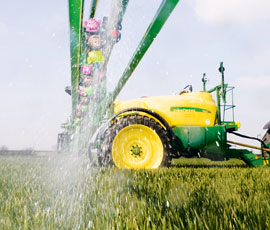EU focus on water protection intensifies

It’s long been suspected that Europe lags behind the UK in spraying practice, but much work is being carried out there to help protect water from pesticides.
Given good practice, there is no reason why water contamination by pesticides cannot be cut significantly, according to Friedhelm Schmider, director general of the European Crop Protection Association (ECPA)*.
Studies show that minor technical modifications and changes in farmers’ behaviour to address potential contamination from so-called point sources (eg during sprayer filling) and diffuse sources (eg run-off and spray drift) can have a big impact on water quality, he notes.
“Getting the awareness of those findings out to everyone at EU level might need some time,” he acknowledges.
The latest initiative to help spread the message is the TOPPS-prowadis (Train the Operator to Promote best Practices and Sustainability – PROtecting WAter from DIffuse Sources) project, which is building on work begun in 2005 to minimise problems arising from point sources.
The new three-year €2m project is homing in on measures to counteract water pollution from diffuse sources and offer overall best-practice advice, explains chairman Philippe Costrop of Syngenta. “We’re developing complementary tools and clear, practical recommendations on how to put them into place locally.”
The initial work under the TOPPS acronym focused on developing best management practices, along with training and demonstration material, to address losses from inappropriate handling of pesticides mainly during filling and cleaning of spraying equipment.
“These activities can have a big impact,” says Mr Costrop. “We know from certain studies that point sources can contribute to at least 50% of the amount of pesticides found in water.”
A single spilled drop of concentrated product might contain only one gram of active ingredient, but it would need 10m litres of water to dilute it to below the “arbitrary non-science-based” threshold of 0.1ppb (0.1ug/litre) level of the Drinking Water Directive (98/83/EC), he points out.
“That’s why the work first focused on point sources and created the basis and expert network for the work we’re now doing under TOPPS-prowadis.
The overall goal is that no detections exceed any legal or science-based thresholds such as the Environmental Quality Standards in water and the Health Based Drinking Water Standards.”
One spin-off of the initial €3.5m project, co-funded by the EC’s Life programme and the ECPA, has been the concept of the environmentally optimised sprayer. An EOS on-line tool that can be found on the TOPPS website* has been developed to help users to evaluate how “water-friendly” their machinery is and how it could be improved, he explains.
The initial project covered 25 countries including the UK. “We had specific activities linked with the UK’s voluntary initiative where we collaborated on promoting the best management practices and on common demonstration activities.”
Unfortunately, notes Mr Costrop, the ECPA was unsuccessful in its bid for more funds from Life; so the new TOPPS-prowadis project covers only seven countries, excludes the UK and is supported solely by the ECPA.
“We had to compromise between meeting our objectives and having a good spread across the EU. But although we have a budget for only seven countries, all the others can freely use the TOPPS literature we produce because we develop the core documents in such a way that they are on a EU-basis.”
The latest project aims to develop by 2014 a broad integrated water protection approach covering both point and diffuse sources through national action plans and river basin management plans.
Long-term experiments in France and Sweden suggest that by combining best management practices for both sources, water protection can be greatly enhanced, he explains. “Some of these studies show that pesticide losses to water can be reduced by as much as 90%.”
In France watershed experiments begun in 1997 by the Arvalis Institute covered three areas:
- A river basin of 20,136ha involving 20 farmers in Fontaine du Theil, north of Rennes in Brittany
- Peron, a watershed area in the department of Aisne covering 14,000ha and 76 farmers
- An Agriper’Aisne project in Northern France covering 480,000ha and 300 farmers.
The work involved three phases, explains Mr Costrop.
The first identified the sources of pesticides and how they were being transferred to water, for example by run-off or drift.
Field run-off can account for more than 30% of pesticide losses and drift more than 3%, he notes, but there are local differences. “In the Netherlands, for example, drift is more important than run-off.”
The second phase involved drawing up action plans, and the third monitored the outcome of improved farming practices on water quality, notes Mr Costrop.
Measures to reduce pollution pressures included advice on changes in practices and training project managers in the use of various diagnostic tools.
Farmers were trained to adjust their sprayers, while buffer zones consisting of grass filter strips, hedges and embankments, fallows and permanent grassland were established. Farmyards were managed to prevent pesticide leaching during storms and a “zero faults on accidental pollution” demonstration farm was set up.
A watershed demonstration area was also created, in which chemical controls were replaced by mechanical methods with tillage performed across slopes, and over-winter plant cover was established ahead of spring crop plantings.
“In Fontaine du Theil, the level of active substances measured in water samples fell from 22% in 1998-99 to 5% in 2005-06,” says Mr Colstrop. “And the legal limit of 5ug/litre for a combination of active ingredients in drinking water wasn’t exceeded after the third year of the project.
“In the Peron area, only herbicides used outside agriculture were detected in the river in 2007.”
In Sweden similar work on agricultural land has been conducted since 1990, he adds. “The world-famous Vemmenhögprojekt in southern Sweden shows that losses of pesticides can be reduced by over 90%.”
Keep up to date with the latest arable news

